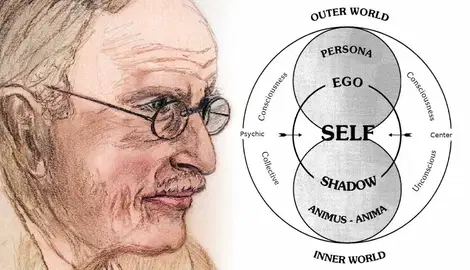
Carl Jung, a student of Freud, saw the psyche as a multi-layered entity that consisted of separate but interacting systems, just like his mentor but with a different perception.
In his own words:
“By psyche I understand the totality of all psychic processes, conscious as well as unconscious.”
To Jung, the psyche consisted of thoughts, feelings, memories, and instincts present in the conscious, personal unconscious, and collective unconscious psychological landscapes of the human mind.
The Three Layers of the Psyche include;
1. The Ego (Conscious Mind)
The ego is the center of the field of consciousness — the part of our psyche where our conscious awareness resides, and where our sense of identity and existence is formed.
It mediates between the inner and outer worlds, shaping our perceptions. It represents our sense of personality, i.e., everything after the phrase “I.”
2. Personal Unconscious
Underneath awareness lies a layer that contains our individual forgotten experiences, unresolved issues from the past, repressed memories, desires, and emotions.
The personal unconscious also contains the shadow — the aspects of our personality we hide or deny out of a need to conform.
Here too lie complexes, which are emotional patterns associated with memories that arose from our interactions with certain stimuli in the past (e.g., the mother complex).
In Jung’s words:
“Everything of which I know, but of which I am not at the moment thinking; everything of which I was once conscious but have now forgotten; everything perceived by my senses, but not noted by my conscious mind; everything which, involuntarily and without paying attention to it, I feel, think, remember, want, and do; all the future things which are taking shape in me and will sometime come to consciousness; all this is the content of the unconscious.” (Jung, 1921)
3. The Collective Unconscious
Unlike Freud, Carl Jung acknowledged the existence of a Collective Unconscious, which is shared by all members of the human species.
According to Jung, our human mind has innate characteristics imprinted on it as a result of evolution, coupled with universal symbols and themes shared across all cultures. He referred to these as archetypes.
As Saul McLeod, Ph.D., defines it: it’s like an inherited mental library filled with books (archetypes) everyone shares, regardless of culture.
“The form of the world into which [a person] is born is already inborn in him, as a virtual image.” (Jung, 1953, p. 188)
Key Structures of the Psyche
The Self
This is the unified center of the world — the sum total of the psyche. The Self is innate from the start but must be rediscovered through inner work. It aims for wholeness and the integration of all aspects of the personality.
Persona
This is the social mask we wear to function in society.
The term Persona refers to the part of us we allow the world to see. In fact, what many call “personality” is derived from the term persona, which means “mask” in Latin.
This mask is built out of the need to conform to societal expectations and norms.
The Shadow
The shadow is like the flip side of the persona — a part of our personal unconscious that contains everything we deny, reject, or aren’t willing to acknowledge about ourselves.
It contains our flaws, instincts, repressed and untapped desires. Our darker aspects, such as envy, anger, and resentment, are stored here. Equally, positive qualities may also be found in the shadow. For example, a timid person might have their bold personality repressed there.
The shadow, however, leaks through means such as projection, sudden moments of emotional outburst, and dreams.
The Anima/Animus
The anima is the feminine aspect of the male psyche, while the animus is the masculine aspect of the female psyche.
The anima and animus contain inner images that are formed through our interactions with the opposite gender. These inner images often lead to projection.
Unlike Freud, Jung believed everyone’s psyche observes the law of duality, with both masculine and feminine qualities present.
Individuation
Individuation is the process of making the unconscious conscious, balancing opposing forces, and reconciling different aspects of the psyche to achieve wholeness.
The main aim is to bring unconscious aspects such as hidden emotions, thoughts, and beliefs into conscious awareness for understanding and acceptance, lest they control our entire lives.
In Jung’s words:
“Unless you make the unconscious conscious, it will direct your life and you will call it fate.”
This process is mainly done through awareness, shadow work, dream analysis, and embracing opposing forces such as rational and emotional, strength and vulnerability, thinking and feeling.
In summary:Carl Jung’s model of the psyche highlights the intricate structure of the human mind. By understanding the ego, personal unconscious, collective unconscious, and key archetypal elements like the persona, shadow, anima/animus, and self, we can better understand ourselves and work toward psychological integration and wholeness.
